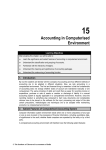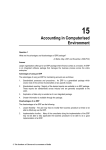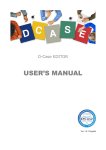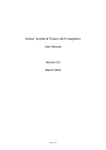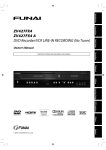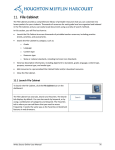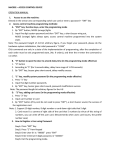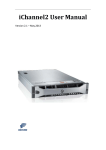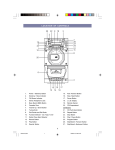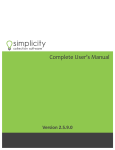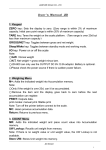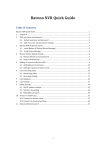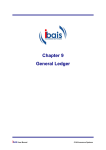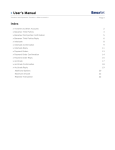Download Accounting in Computerised Environment
Transcript
15 Accounting in Computerised Environment Learning Objectives After studying this chapter, you will be able to: ♦ Learn the significance and salient features of accounting in computerised environment. ♦ Understand the classification and grouping of accounts. ♦ Familiarize with the hierarchy of ledgers. ♦ Understand the meaning and significance of accounting packages. ♦ Understand the outsourcing of accounting function 1. Introduction By now the students are familiar with the concepts of accounting and how different methods of accounting are to be adopted in different situations. Now, we look accounting in a computerised environment. The first and foremost thing to remember is that the fundamentals of accounting does not change whether books of account are maintained manually or are computerised. The same principles of debit and credit that we apply for recording income or expenditure, purchase or sale of assets or creation or discharge of liability in a manual accounting system is equally applicable in a computerised environment. However, since the recording medium is something else compared to hard copy documents and considerable reliance have to be placed on the software for the input, processing and output of the data certain precautions, methodologies and techniques are to be adopted while maintaining accounts in a computerised environment. 2. Salient Features of Computerised Accounting System Computer information system environment exists when one or more computer(s) of any type or size is (are) involved in the processing of financial information, including quantitative data, of significance to the audit, whether those computers are operated by the entity or by a third party. © The Institute of Chartered Accountants of India Accounting In Computerised Environment 15.2 A computerised accounting environment will therefore have the following salient features: 1. Fast, Powerful, Simple and Integrated: Computerized accounting is designed to automate and integrate all the business operations, such as sales, finance, purchase, inventory and manufacturing. With computerized accounting, accurate, up-to-date business information is literally at the fingertips. Computerized accounting has user-definable templates which provides fast, accurate data entry of the transactions. Computerized accounting has the ability to handle huge volumes of transactions without compromising on speed or efficiency. 2. Complete Visibility & Scalability: With Computerized accounting the company will have greater visibility into the day-to-day business operations and access to vital information. Computerized accounting adapts to the current and future needs of the business, irrespective of its size or style. 3. Customised: Computerized accounting allows the company to enter data in a variety of ways which makes work a pleasure. Adapting to the specific business needs is possible. Hence, a software can be tailor-made accordingly to the need of the business. 4. For quick decision making & improved Business Performance: Computerized accounting is a highly integrated application that transforms the business processes with its performance enhancing features which encompass accounting, inventory, reporting and statutory processes. This helps the company access information faster, and takes quicker decisions. Computerized accounting also guarantees real-time optimization of operations and enhanced communication.It generates real-time, comprehensive MIS reports and ensures access to complete and critical information, instantly. 3. Significance of Computerised Accounting System With computers becoming extensively used in business today, it is obvious that accounts which were earlier maintained in a manual form will be gradually replaced with computerised accounts. The speed with which accounts can be maintained is several fold higher. Basic difficulties faced like balancing of trial balance, correct posting into the general ledger and subsidiary ledger is a thing of the past. Today any person maintaining accounts in the computer does not have to consider that while making say a cash expense entry through the cash payment screen that the corresponding ledger posting of the expense has been done properly or not. Similarly the trial balance should automatically tally unless some mistake is made while recording the opening balances. The only concerns that have increased today are concerns for controls, security and integrity of the computer system as more and more information is stored not in the hard print but as © The Institute of Chartered Accountants of India 15.3 Accounting soft copies inside the computer. Issues like unauthorised access to the data either through the local area network or through the internet by hacking into the company server are becoming potential threat to the computer usage. 4. Codification and Grouping of Accounts Unlike a manual accounting system where account codes are rarely used a computerised accounting system frequently uses a well defined coding system. However, it should not be concluded that computerised account must always have account codes. There are many accounting softwares available which support a non-coded accounting system. A coded accounting system is more convenient where there are numerous account heads and the complexity is high. It also to some extent reduces the possibility of the same account existing in several names due to spelling mistakes or abbreviations used. A proper codification requires a systematic grouping of accounts. The major groups or heads could be Assets, Liabilities, Revenue Receipts, Capital Receipt, Revenue Expenditure, Capital Expenditure. The sub-groups or minor heads could be "Cash" or "Receivables" or "Payables" and so on. The grouping and codification is dependant upon the type of organisation and the extent of sub-division required for reporting on the basis of profit centres or product lines. There could a classification based on geographical location as well. (a) The main unit of classification in accounts should be the major head which should be divided into minor heads, each of which should have a number of subordinate heads, generally shown as sub-heads. The sub-heads are further divided into detailed heads. Sometimes major heads may be divided into 'sub-major heads' before their further division into minor heads. The Major heads, Minor heads, Sub-heads and Detailed heads together may constitute a four tier arrangement of the classification structure of Accounts. (b) Major heads of account falling within the Receipt Heads (Revenue Account) may correspond to different activities or line of business of the company such as car manufacture, servicing of cars, repairs and maintenance of cars, while minor heads subordinate to them shall identify the specific manufacturing activity like manufacture of car body, components and spare parts, etc. A manufacture of car body may consist of a number of activities like the manufacture of the chasis, the door, the front panel, the rear panel, etc. These will then correspond to 'sub-heads' below the minor head represented by the main activity - car manufacture. (c) A "detailed head'' is often termed as an object classification. In the expenditure account being considered in the above example the main purpose of the detailed head is to control expenditure on an item to item basis and at the same time group the objects according to the nature. Example of such detailed head could be 'Salaries', 'Office Expenses', 'Salesman Expenses', 'Workshop Overhead', etc. © The Institute of Chartered Accountants of India Accountin ng In Computerised Envi ronment (d) 15.4 The detailed classification of acccount heads and the order in which thee Major and Minor M ment headss shall appear in all accouunt records shhould be approved by the top managem of the organisation and should be b reviewed by b the auditor before they are introduceed in the coomputerised accounting a ennvironment. Classificattion of Accounnts Maajor Heads [Assets, Liabilities etcc.] Minor Heeads [Cash, Receeivables, Inventoriess etc.] Sub-Heads S [Petty Casyh, C Main Cash C etc.] 5. Maintaaining thee Hierarchyy of Ledgeers Once the claassification off accounts innto various grroups is complete and coodification is done d after formatioon of major, minor, sub and a detailed heads h the saame is required to be inseerted into the compputer system.. Account masster files are created c with codes c and deescription of thhe accounts. Some accounting software alloows ledgers and subsidiaary ledgers too be createdd from the m main ledgers. The subsidiary leedgers can further f be suubdivided to sub subsidiiary ledgers thereby alloowing grouping undder various profit centres. These are particularlyy useful wheere accountss are maintained without w codess. In a coded system thiis is easily achieved a by alloting codees to major, minor,, sub and dettailed heads and a thereafter obtaining reeports based oon these codes. Apart from thhe general leedger and thee subsidiary ledger (or thhe sub-subsiddiary ledger as a is available in some s softwarre) there are other ledger accounts thaat are automaatically createed by any standardd accounting software. s Theese are the deebtors ledger and the credditors ledger. At the time of creation of o the account heads som me of account heads aree indicated too the system as cash account,, bank accouunt, debtors account a and creditors ac count. Thereeafter whenever ann entry is made say withh a cash acccount and a bank accouunt the compputer automaticallyy indicates it as a a contra inn the reports. Similarly when a sale transaction is made, m the reflectionn is given in the debtors account a and when a purcchase transacction is madee the reflection goees to the credditors accountt. Another important ledger which form ms part of most m standardd accountingg package iss the o the moveement of invenntory inventory ledger. In simplee accounting softwares thiis may give only © The Institute of Chartered Accountants of India 15.5 Accounting items without valuation of inventories. However, many of the packages give the option of valuation of inventories based on the method of costing set like the FIFO, LIFO, weighted average, etc. 6. Accounting Packages Accounting software is an invaluable resource for modern business. Software allows detailed tracking of financial transactions and near instantaneous reporting and analysis. Selection of the accounting software dependents upon the requirement of business. If you have small organization that makes only a few basic transactions a month—deposits, withdrawals and invoices, you can even use a spread sheet package like Microsoft Excel. If your business is growing fast you should consider using pre-packaged accounting software like, Sage, Tally, or, FACT or any other billing software. At the higher end if you are in service industry or your business has some specific requirements which are not available in common pre-packaged software, you will have to go for customised accounting software. Larger organisations go often for an ERP package where finance comes as module. An ERP is an integrated software package which manages the business process across the entire enterprise. 6.1 Spread Sheets Account can be maintained in a computerised environment even by using a spread sheet package. User will have to use his knowledge and skills of spread sheet software to keep control of the figures. Special spreadsheet controls including physical spreadsheet controls like spreadsheets locked on a protected shared drive with restricted access and read/write access controls and password-protected cells and formulas with passwords should be used. Advantages of spreadsheet software as an accounting tool are: 1. It is simple to use and easy to understand 2. Most of the common functions like doing calculations, setting formulas, macros, replication of cell contents, etc can be easily done in a spreadsheet. 3. Grouping and regrouping of accounts can be done. 4. Presentation can be made in various forms including graphical presentations like bar diagram, histogram, pie-chart, etc. 5. Basic protection like restricted access and password protection of cell can be used to give security to the spread sheet data. © The Institute of Chartered Accountants of India Accounting In Computerised Environment 15.6 Disadvantages of a spreadsheet as an accounting tool are: 1. It has data limitations. Depending upon the package they can accept data only up to a specified limit. 2. Simultaneous access on a network may not be possible. Many of the modern softwares allow locking of the table when updation is taking place. This is not possible in a spread sheet. 3. Double entry is not automatically completed. Formulas or other means have to be adopted to complete the double entry. 4. Reports are not automatically formatted and generated but have to be user controlled. Each time a report has to be printed, settings have to be checked and data range has to be set. In many accounting software this is automatically taken care of by the program. 6.2 Prepackaged Accounting Software There are several prepackaged accounting software which are available in the market and are used extensively for small and medium sized organisations. These softwares are easy to use, relatively inexpensive and readily available. The installation of these softwares are very simple. An installation diskette or CD is provided with the software which can be used to install the software on a personal computer. A network version of this software is also generally available which needs to be installed on the server and work can be performed from the various workstations or nodes connected to the server. Along with the software an user manual is provided which guides the user on how to use the software. After installation of the software, the user should check the version of the software to ensure that they have been provided with the latest. The vendor normally provides regular updates to take care of the changes of law as well as add features to the existing software. These softwares normally have a section (customer master file) which provides for the creation of a company. The name, address, phone numbers and other details of the company like VAT registration number, PAN and TAN numbers are feeded into the system. The accounting period has to be set by inserting the first and the last day of the financial year. The next step in the use of this software could be the creation of accounts. This is done by adding the accounts along with their codes into the master file files. Each account has to be classified into whether it is an asset or liability or an income or expenditure account. Whether the account has other subsidiary ledgers under it needs to be indicated to the system. The opening balances are to be entered into the master file files. The company parameters need to be set at this point of time so that the accounts which are the cash, bank, sundry debtors, sundry creditors, etc are known to the system. The customers name, address and other basic details are also entered in the customer master file. Similarly, the creditors details are entered into the creditor master file files. Product details are entered through the product master file files. Here the unit of measurement and the opening stock quantities including the values are © The Institute of Chartered Accountants of India 15.7 Accounting provided. The system of valuation of stock like the FIFO, LIFO, Weighted average, etc are defined in the product master file files. Once the basic parameters are set and the master files are updated, the system is ready for use. To summarise, any standard prepackaged software will have the following master file screens: • Company master file • Accounts master file • Sub ledger master file • Customer master file • Vendor master file • Product master file • Division master file The entry screens differ in look and feel from software to software and from vendor to vendor. However, the basic entry screens are the following: • Cash Receipts and Payment Entry • Bank Receipts and Payment Entry • Petty Cash Voucher Entry • Journal Entry • Purchase Order, GRN, Bill, Purchase return Entry • Sales Order, Challan, Invoice, Sales Return Entry • Debit Notes and Credit Notes Entry • Cash Sales & Purchase Memos • Production • Consumption • Stock Transfer Each of the screens are provided with the add, modify or delete options. Special options like the date modification and voucher number modifications are provided in some of the softwares. The next section that the software provides is the reports section where the following reports are common to most of the softwares : • Cash Book • Bank Book • Petty Cash Book • Purchase Book © The Institute of Chartered Accountants of India Accounting In Computerised Environment • Sales Book • Cash Sales Book • Cash Purchase Book • Sales Return register • Purchase Return register • Journal Book • General Ledger • Subsidiary Ledger • Debtors Ledger • Creditors Ledger • Debit Note Register • Credit Note Register • Stock Ledger • Stock movement register • Production register • Consumption register 15.8 Some of the softwares provide bank reconciliation options. In the entry screen date of clearances can be inserted. Reports can thereafter be generated of all uncleared items to make the BRS report. There are special reports also provided by some softwares like the cash, bank maintenance reports which shows any date on which the cash or bank by mistake had credit balance. There are also MIS reports like aging of debtors, slow moving and non-moving stock, etc. The last section also called the house keeping section of these softwares provide the system maintenance features. Backup can be taken and restored under the housekeeping section. Clean-up, fine tuning and re-indexing of the software is part of this section of the software. 6.2.1 Advantages of Pre-Packaged Accounting Software Pre-packaged Accounting Software has many advantages. The significant advantages are as follows: 1. Easy to install: The CD or floppy disk is to be inserted and the setup file should be run to complete the installation. 2. Relatively inexpensive: These packages are sold at very cheap prices nowadays. 3. Easy to use: Mostly menu driven with help options. Further the user manual provides most of the solutions to problems that the user may face while using the software. © The Institute of Chartered Accountants of India 15.9 Accounting 4. Backup procedure is simple: Housekeeping section provides a menu for backup. The backup can be taken on floppy disk or CD or harddisk. 5. Flexibility: Certain flexibility of report formats provided by some of the softwares: This allows the user to make the invoice, challan, GRNs look the way they want. 6. Very effective for small and medium size businesses: Most of their functional areas are covered by these standardised packages. 6.2.2 Disadvantage of Pre-packaged Accounting Software Some of the important Disadvantages of Pre-packed Accounting Software are as follows: 1. Does not cover peculiarities of specific business: Business today are becoming more and more complex. A standard package may not be able to take care of these complexities. 2. Does not cover all functional area: For example production process may not be covered by most pre-packaged accounting software. 3. Customisation may not be possible in most such softwares: The vendors for these softwares believe in mass sale of an existing source. The expertise for customisation may not have been retained by the vendor. 4. Reports generated is not sufficient or serve the purpose: The demands for modern day business may make the management desire for several other reports for exercising management control. These reports may not be available in a standard package. 5. Lack of security: Any person can view data of all companies with common access password. Levels of access control as we find in many customised accounting software packages are generally missing in a pre-packaged accounting package. 6. Bugs in the software: Certain bugs may remain in the software which takes long to be rectified by the vendor and is common in the initial years of the software. 6.2.3 Consideration for Selection of Pre-Packaged Accounting Software There are many accounting softwares available in the market. To choose the accounting software appropriate to the need of the organisation is a difficult task. Some of the criteria for selection could be the following: 1. Fulfilment of business requirements: Some packages have few functionalities more than the others. The purchaser may try to match his requirement with the available solutions. 2. Completeness of reports: Some packages might provide extra reports or the reports matches the requirement more than the others. 3. Ease of use : Some packages could be very detailed and cumbersome compare to the others. © The Institute of Chartered Accountants of India Accounting In Computerised Environment 15.10 4. Cost : The budgetary constrainsts could be an important deciding factor. A package having more features cannot be opted because of the prohibitive costs. 5. Reputation of the vendor: Vendor support is essential for any software. A stable vendor with reputation and good track records will always be preferred. 6. Regular updates : Law is changing frequently. A vendor who is prepared to give updates will be preferred to a vendor unwilling to give updates. 6.3 Customised Accounting Software A customised accounting software is one where the software is developed on the basis of requirement specifications provided by the organisation. The choice of customised accounting software could be because of the typical nature of the business or else the functionality desired to be computerised is not available in any of the prepackaged accounting software. An organisation desiring to have an integrated software package covering most of the functional area may have the financial module as part of the entire customised system. A feasibility study is first made before the decision to develop a software is made. The life cycle of a customised accounting software begins with the organisation providing the user requirements. Based on these user requirement the system analyst prepares a requirement specification which is given for approval by the user management. Once the requirement specification is approved, the designing process begins. Development, testing and implementation are the other components of the system development life cycle. 6.3.1 Advantages of a Customised Accounting Package Advantages of a customised accounting package are the following: 1. The functional areas which are not in pre-packaged software covered gets computerised. 2. The input screens can be tailor made to match the input documents for ease of data entry. 3. The reports can be as per the specification of the organisation. Many additional MIS reports can be included in the list of reports. 4. Bar-code scanners can be used as input devices suitable for the specific needs of an individual organisation. 5. The system can suitably match with the organisational structure of the company. 6.3.2 Disadvantages of a Customised Accounting Package The disadvantages which may arise in a customised accounting package are the following: 1. Requirement specifications are incomplete or ambiguous resulting in a defective or incomplete system. 2. Inadequate testing results in bugs remaining in the software. © The Institute of Chartered Accountants of India 15.11 Accounting 3. Documentation is not complete. 4. Frequent changes made to the system with inadequate change management procedure resulting in system compromise. 5. Vendor unwilling to give support of the software due to other commitments. 6. Vendor not willing to part with the source code or enter into an escrow agreement. 7. Control measures are inadequate. 8. Delay in completion of the software due to problems with the vendor or inadequate project management. The choice of customised accounting packages is made on the basis of the vendor proposals. The proposals are evaluated as to the suitability, completeness, cost and vendor profiles. Generally preference is given to a vendor who has a very good track record of deliverables. 7. Accounting Software as Part of Enterprise Resource Planning (ERP) An ERP is an integrated software package that manages the business process across the entire enterprise. 7.1 Advantages of Using an ERP The advantages of using an ERP for maintaining accounts are as follows: 1. Standardised processes and procedures : An ERP is a generalised package which covers most of the common functionalities of any specific module. 2. Standardised reporting : Majority of the desired reports are available in an ERP package. These reports are standardised across industry and are generally acceptable to the users. 3. No Redundancy :Duplication of data entry is avoided as it is an integrated package. 4. Better Information :Greater information is available through the package. 7.2 Disadvantages of an ERP The disadvantages of an ERP are the following: 1. Lesser flexibility : The user may have to modify their business procedure at times to be able to effectively use the ERP. 2. Implementation hurdles : Many of the consultants doing the implementation of the ERP may not be able to fully appreciate the business procedure to be able to do a good implementation of an ERP © The Institute of Chartered Accountants of India Accounting In Computerised Environment 15.12 3. Very expensive : ERP are normally priced at an amount which is often beyond the reach of small and medium sized organisation. However, there are some ERP coming into the market which are moderately priced and may be useful to the small businesses. 4. Complexity of the software : Generally an ERP package has large number of options to choose from. Further the parameter settings and configuration makes it a little complex for the common users. 7.3 Choice of an ERP Choice of an ERP depends upon the following factors: 1. Functional requirements of the organisation : The ERP that matches most of the requirements of an organisation is preferred over the others. 2. Reports available in the ERP : The organisation visualises the reporting requirements and choses a vendor which fulfils its reporting requirements. 3. Background of the vendors : The service and deliverable record of a vendor is extremely important in chosing the vendor. 4. Cost comparisons :The budget constraints and fund position of an enterprise often becomes the deciding factor for choosing a particular package. 8. Outsourcing of Accounting Function Recently a growing trend has developed for outsourcing the accounting function to a third party. The consideration for doing this is to save cost and to utilise the expertise of the outsourced party. The third party maintains the accounting software and the client data, does the processing and hands over the report from time to time. 8.1 Advantages of Outsourcing the Accounting Functions The advantages of outsourcing the accounting functions are the following: 1. Saving of time: The organisation that outsources is able to save time to concentrate on the core area of business activity. 2. Utilisation of expertise of the third party: The organisation is able to utilise the expertise of the third party in undertaking the accounting work. 3. Data management by professional: Storage and maintenance of the data is in the hand of professional people. 4. Less dependence on key accounting positions: The organisation is not bothered about people leaving the organisation in key accounting positions. 5. Economical: The proposition often proves to be economically more sensible. © The Institute of Chartered Accountants of India 15.13 8.2 Accounting Disadvantages of Outsourcing the Accounting Functions The disadvantages of outsourcing are as follows: 1. Lack of security & confidentiality: The data of the organisation is handed over to a third party This raises two issues, one of security and second of confidentiality. There have been instances of information leaking out of the third party data centres. 2. Inadequate services provided : The third party is unable to meet the standards desirable. 3. High cost: The cost may ultimately be higher than initially envisaged. 4. Delay in obtaining services: The third party service providers are catering to number of clients thereby processing as per priority basis. 8.3 Choice of outsourcing vendor The choice of outsourcing vendor is made on the basis of the proposals received from these vendors. The proposals are evaluated and the decision is often taken based on the following criteria: 1. The amount of services provided and whether the same matches with the requirements. 2. The reputation and background of the vendor. 3. The comparative costs of the various propositions. 4. The assurance of quality. 9. Consideration for choice of different alternatives of accounting softwares After having discussed about the possible alternatives for having accounting in a computerised environment it is important to understand how a choice can be made from all the alternatives viz. spread sheet packages, pre-packaged accounting software, customised accounting package, ERP package and outsourcing the accounting function to a third party. The possible considerations are as follows: 1. Size of business operation: If the size of the operation is small or medium the organisation can opt for a prepackaged accounting package. However, if the size is big, the organisation may decide upon a customised software or an ERP package. 2. Complexity of operation: If the operation is complex with several functional areas which needs to be computerised the choice is usually a customised software or an ERP package. 3. Business requirement:. If the organisation has several non-standard requirements then customised software could be the solution. © The Institute of Chartered Accountants of India Accounting In Computerised Environment 4. 15.14 Budgetary constraints: Cost consideration could also be a deciding factor for the choice of a particular alternative. Normally the spread sheet and the prepackaged accounting software works out to be the cheapest. The customised software and the ERP are of higher cost considerations. 10. Generating Reports from Software Spreadsheet softwares can be utilised to generate accounting reports. Formats have to be defined by the user and can be used to view or print the reports. In a pre-packaged accounting software reports are generated from the package.The user is allowed to define the period of the report which should fall within the accounting period for which the report is required. Reports as on a particular date should also be falling within the accounting period.The reports generally have the option of being viewed on the screen, or printed out through the printer or saved on to a file. Saved file may be in the text format or spreadsheet format depending upon the software being used. Reports from the pre-packaged software are mostly in a pre-determined format. However, some of the softwares allow certain customisation of the formats of the report. For example the look of the invoice or challan can be printed according to the style normally used by the company. Summary Significance of computerised accounting: • Increase the speed, Accuracy, Security • Reduce the error • Remove the duplicacy of work • Immediate information Accounting Package: • Maintained by using a spread sheet package, • Pre-Packaged Accounting Software • Customised Accounting Software • ERP Role of Computer in accountancy: • Controlling operations • Deciding sequence of operations • Accounting operations © The Institute of Chartered Accountants of India 15.15 Accounting Advantages of Pre-Packaged Accounting Software: • Easy to install • Relatively inexpensive • Easy to use • Backup procedure is simple • Certain flexibility of report formats provided by some of the softwares • Very effective for small and medium size businesses Disadvantage of Pre-packaged Accounting Software: • Does not cover peculiarities of specific business • Does not cover all functional area • Customisation may not be possible in most such softwares • Reports generated is not sufficient or serve the purpose • Lack of security • Bugs in the software Consideration for Selection of Pre-Packaged Accounting Software: • Fulfilment of business requirements • Completeness of reports • Ease of use • Cost • Reputation of the vendor • Regular updates Customised Accounting Software: where the software is developed on the basis of requirement specifications provided by the organisation ERP : Integrated software package manages the business process across the entire enterprise. Advantages of ERP • Standardised processes and procedures • Standardised reporting • Avoided Duplication of data entry • Availability of Greater information Disadvantages of an ERP • Lesser flexibility • Implementation hurdles • Very expensive : • Complexity of the software © The Institute of Chartered Accountants of India Accounting In Computerised Environment Choice of an ERP: • Functional requirement of the organisation • Reports available in the ERP • Background of the vendors • Cost comparisons Outsourcing of accounting function: Accounting function done by the third party. Advantages • Time saving • Use of the expert knowledge • Maintenance of the data is in the hand of professional people • Economically Disadvantages • The data of the organisation is handed over to a third party • Inadequate services provided • Higher cost • Delay in obtaining services © The Institute of Chartered Accountants of India 15.16
















